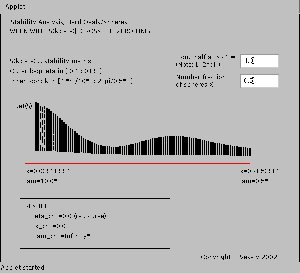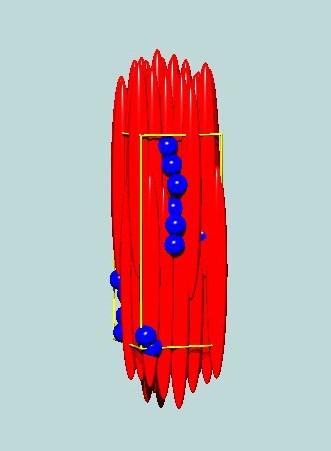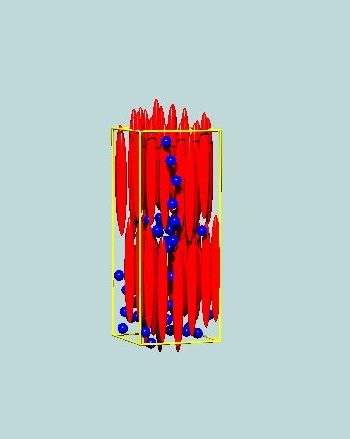


Back to WEBLOG
KODA THEORY FOR HGO-HGS MIXTURES
Franz J. Vesely, August 2003
DC, will you please check me?
Here are some considerations on applying Koda's ideas to a mixture
of Hard Gaussian Overlap particles and Hard Gaussian Spheres (HGS).
By the latter we simply mean HGOs with
 .
For simplicity we also assume that the two components have the same
(half) thickness
.
For simplicity we also assume that the two components have the same
(half) thickness  .
.
Let
 be the semi(!)axes of the HGO (species 1)
particles. For an encounter between two parallel HGOs the forbidden
volume is then an ellipsoid with semiaxes
be the semi(!)axes of the HGO (species 1)
particles. For an encounter between two parallel HGOs the forbidden
volume is then an ellipsoid with semiaxes
 and
and
 . For two HGS the radius of the forbidden volume is
. For two HGS the radius of the forbidden volume is
 , and for the unlike interaction the semiaxes are
, and for the unlike interaction the semiaxes are
 and
and
 .
.
The packing density is ill defined, as our HGOs have no constant shape.
Remembering that the original idea of Berne-Pechukas was
... representing, in some sense, the distribution of matter in one of our
molecular ellipsoids, the spacial extent of the distribution being of
order  ...
...
we may define the molecular volumes to be
 and
and
 with
with
 . Thus the packing density becomes, with the
number fractions
. Thus the packing density becomes, with the
number fractions  (HGO) and
(HGO) and  (for HGS),
(for HGS),
![\begin{displaymath}
\eta=\rho v_{HGS} \left[ X f_{HGO} + (1-X)\right]
\end{displaymath}](img13.png) |
(1) |
If all these definitions and relations are reasonable, then the following
applet should give the results of Koda's theory.
Following DC's suggestion, I introduced a fudge factor  allowing for a shorter
excluded volume between HS and HGO. It turns out that with
allowing for a shorter
excluded volume between HS and HGO. It turns out that with  , a HS number
fraction of
, a HS number
fraction of  and a long axis
and a long axis  Koda predicts smectic layering at
Koda predicts smectic layering at
 , with a period of
, with a period of  (with larger step sizes in
(with larger step sizes in  and
and  I found
I found  , period
, period  .)
.)
This is corroborated by MC, as seen from the figures. In the second image the
particle dimensions are reduced by 1/2 to make the structure more
transparent.


 F. J. Vesely / University of Vienna
F. J. Vesely / University of Vienna
 and
and
...
 Applet Koda_hgo:
Start
Applet Koda_hgo:
Start
![]() , with a period of
, with a period of ![]() (with larger step sizes in
(with larger step sizes in ![]() and
and ![]() I found
I found ![]() , period
, period ![]() .)
.)

